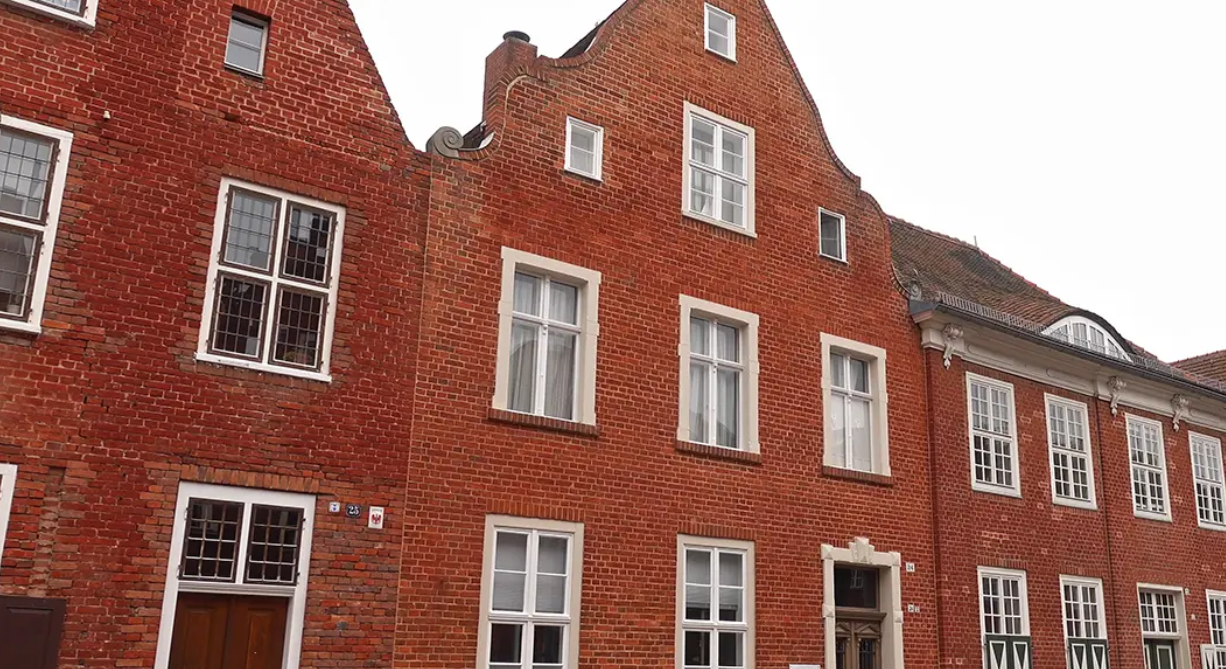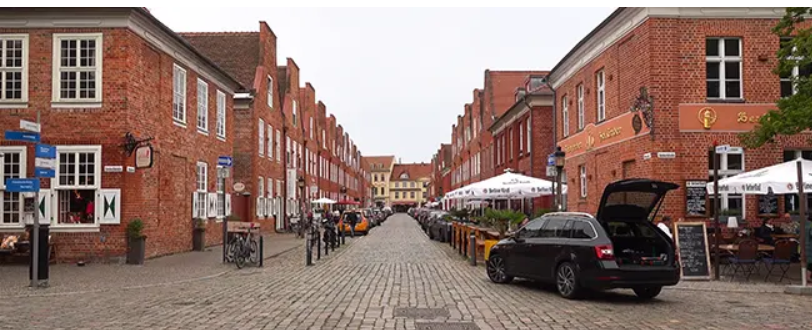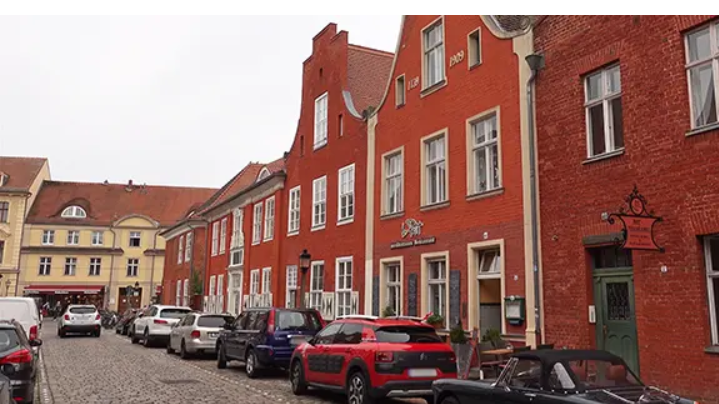A district built for Dutch craftsmen in the center of Potsdam
Address: Dutch Quarter, Benkertstraße 6-12, 14467 Potsdam | Built: 1734 to 1742
The Dutch Quarter in Potsdam is quaint, cozy, and rather unusual. It is home to 150 brick houses in a distinctive architectural style, arranged in four blocks. A stroll through it quickly gives you the feeling of being in a typical Dutch town. The houses are lined up in rows along cobblestone streets. Some feature curved gables, pretty shutters, and white-pointed bricks in their natural color, creating a very special picture and enchanting charm.
Directions and location of this Potsdam landmark
The Dutch Quarter, colloquially known as the Dutch Quarter, is located in the historic center of Potsdam. It was built for Dutch craftsmen who worked and settled in Potsdam during the Prussian era. The quarter is framed by Hans-Thomas-Straße, Hebbelstraße, Leiblstraße, and Gutenbergstraße. Its unique architecture sets it apart from the surrounding buildings.
Opening Hours and Tours
The Dutch Quarter is open to the public at any time, as it is a public area in Potsdam.

Entrance Fees for the Dutch Quarter
There are no entrance fees to enter the Dutch Quarter.
Guided Tours of the Dutch Quarter
Guided tours of the Dutch Quarter are available to delve into the district’s history, admire its distinctive architecture, and discover unique features.
FAQ – Frequently Asked Questions about the Dutch Quarter in Potsdam
What is the Dutch Quarter?
The Dutch Quarter is a historic district in Potsdam. It consists of a collection of approximately 150 red brick houses built in the Dutch style in the 18th century. These houses were built by Dutch artisans and settlers who came to Potsdam at the invitation of the Prussian King Frederick William I to populate the city and introduce craft traditions.
When was the Dutch Quarter in Potsdam established?
The Dutch Quarter in Potsdam was built between 1734 and 1742. During the reign of the Prussian King Frederick William I, Dutch artisans were invited to populate the city and introduce craft traditions. The planning and construction of the district were led by Johann Boumann, a Dutch architect.
Why was the Dutch Quarter established in Potsdam?
The Dutch Quarter in Potsdam was created in the 18th century on the initiative of the Prussian King Frederick William I to accommodate the growing population. Dutch artisans were invited to contribute their skills and promote cultural exchange. It was also intended to serve as a symbol of the ties between Prussia and the Netherlands.
How large is the Dutch Quarter in Potsdam?
The Dutch Quarter in Potsdam covers an area of approximately 16.7 hectares.
Dutch Quarter – Special Features and Interesting Facts
In the heart of Potsdam lies the Dutch Quarter, an ensemble of unique houses unlike any other in Germany. This attractive residential area consists of 150 brick houses built entirely in the Dutch style. Those who stroll through the so-called Dutch Quarter will encounter unplastered house facades made of red bricks with white joints.
The windows have white framed windows, and pretty shutters can be found everywhere. If you look up to the gable, you will see not only stepped gable walls but also some artfully curved structures supporting the roof. The entrances and doors of the houses are tastefully contrasted with the facades, and many house entrances feature special details that are otherwise only found in old neighborhoods in the Netherlands.
There is much to discover on a stroll through the Dutch Quarter. Cozy cafés and restaurants invite you to linger and enjoy a meal, while numerous exclusive shops offer a pleasant atmosphere. The architecture and unique flair of the Dutch Quarter in the heart of Potsdam make it a particularly charming place.

Historical Facts and History of the Dutch Quarter
The Dutch Quarter was built between 1734 and 1742. The Soldier King, King Frederick William I, had it constructed for Dutch craftsmen. The Soldier King had a particular fondness for the country bordering the North Sea and naturally wanted to benefit from the Dutch expertise.
The Dutch not only enjoy a high reputation for their world-famous painters, they are also known for the various Delta Works and waterworks, such as the famous Afsluitdijk. Furthermore, the Dutch already knew how to reclaim new land from the sea. King Frederick William I wanted to utilize all this knowledge.
The construction of the Dutch Quarter was led by Johann Boumann. Much more can be learned about his work in Potsdam at the museum at Mittelstraße 8. During the GDR era, the preservation of the Dutch Quarter was completely neglected. At the end of the 1980s, the Dutch Quarter was in a miserable state and a true eyesore in the city.
After German reunification, the Dutch Quarter was renovated. On September 12, 1990, the city council laid the foundations for restoring the district to its former glory with a redevelopment statute for the Dutch Quarter in Potsdam. Through a perfect interplay of public and private commitment, it was possible to transform the Dutch Quarter into what it is today – a unique and charming part of Potsdam that is a true attraction.

Worth seeing and interesting things in the immediate vicinity of the Dutch Quarter
Strolling through the Dutch Quarter, you’ll find numerous impressive houses in the Dutch architectural style, which always make for great photo opportunities.
Strolling towards Kurfürstenstraße and Hegelallee will automatically lead you to the Nauener Tor. The city gate was built in 1754/1755 in the neo-Gothic style. The designs for the city gate were created by Johann Gottfried Büring. Its construction was intended to give the view of the center of Potsdam along Nauener Straße a new look and enhance it, which was very successful.
A short distance from the Nauener Tor is the Jägertor (Hunter’s Gate), built in 1733. It is the only city gate in Potsdam that has been preserved in its original form. The decorations adorning the gate are particularly impressive. It depicts a par force hunt, which was very popular at the time. Since the city wall was demolished, the Jägertor has stood free, which makes it stand out even more.
Bassinplatz is located near the Dutch Quarter. The square features a 19th-century church building and a beautiful park. The church is the Catholic parish church of St. Peter and Paul. Strolling through the park will reveal a Soviet war cemetery dating back to World War II. Inside the church, you can admire beautiful murals behind the high altar.
If you decide to take a city trip to Potsdam before Christmas, you must visit the Christmas market in the Dutch Quarter. Other events take place throughout the year in the Dutch Quarter, such as the Tulip Festival in spring with cheese, poffertjis, herring, and, of course, tulips in many different colors.
Cafés and Restaurants Near the Dutch Quarter
To sit back and enjoy special delicacies, you don’t have to leave the Dutch Quarter. Numerous restaurants and charming cafés have settled there to spoil their guests with culinary delights.
The Café and Restaurant Collage on Mittelstraße spoils its guests with coffee specialties, ice cream creations, and cakes. The menu always features a changing selection of dishes not found on the standard menu, promising a true culinary delight to be enjoyed in a cozy atmosphere.
Address: Café and Restaurant Collage, Mittelstraße 11
La Maison de Chocolat on Benkertstraße offers its guests French cakes, coffee specialties, a selection of refined dishes, and wines, which can be enjoyed indoors in a tasteful setting or, when the weather is nice, outside, surrounded by pretty Dutch brick houses.
Address: La Maison de Chocolat, Benkertstraße 20
The Restaurant Zum Fliegende Holländer on Benkertstraße is a cozy, stylish brewery. The menu features traditional dishes such as schnitzel and roast beef with sumptuous side dishes. Beer, wine, or soft drinks are also available, and can be enjoyed in a rustic brewery atmosphere or on the large outdoor terrace.
Address: Restaurant Zum Fliegende Holländer, Benkertstraße 5
The 800° Prime Beef Steakhaus is located on Mittelstraße. In addition to rump steak, rump steak, and entrecote, the menu also includes burgers, delicious salads, and various potato dishes. The kitchen team always comes up with something special when it comes to side dishes. The meat is super tender and prepared to perfection.
Address: 800° Prime Beef Steakhaus, Mittelstraße 19
Restaurant Mayas on Hebbelstraße is an Indian restaurant serving traditional, freshly prepared dishes. The dishes are particularly delicious thanks to fresh spices, delicious rice, and crisp vegetables. There are flavorful soups, salads, delicious lamb, chicken, duck, and vegetarian dishes to tantalize your palate. When the weather is nice, you can sit comfortably on the tastefully designed outdoor terrace.
Address: Restaurant Mayas, Hebbelstraße 54